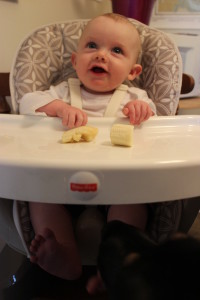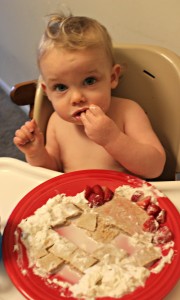When my son started eating food, he skipped the puree stage entirely. I went through all the steps; I bought organic vegetables and meats, went to a playdate with other mommas who made purees for their babies, and I attempted to feed said purees to my then six-month-old. For weeks, he cried every time I broke out the mushed up food and upped his breastfeeding schedule like his life depended on it. I was back to newborn feeding hell. Something had to give.
 When he was seven months old, I decided to try giving him a banana. He not only ate the banana in its entirely, but he screamed for more. Our little eater was off to the races. Over the next several months, he ate anything and everything in sight. In our home, we eat six small meals a day, and he went from one day not eating any food to the next eating six meals. It was incredible and overwhelming.
When he was seven months old, I decided to try giving him a banana. He not only ate the banana in its entirely, but he screamed for more. Our little eater was off to the races. Over the next several months, he ate anything and everything in sight. In our home, we eat six small meals a day, and he went from one day not eating any food to the next eating six meals. It was incredible and overwhelming.
Eventually, we got into a set routine of meals, and I was pleasantly surprised to discover my growing boy wasn’t picky in the least. However, I was concerned about the rate at which he consumed his food, and I called my sister-in-law Jill who happens to be an occupational therapist with six credentialed letters after her name (M.S., O.T.R./L.) to figure out how to slow him down a little. Her suggestion? Utensils!
The best way to teach babies how to use utensils is to begin as soon as they can hold a spoon and are interested. Parents can model for babies how using a spoon works, but at this stage, it’s just about making baby feel comfortable with a utensil in his hand.
Around 8 or 9 months, parents can start helping baby to make the connection that spoons are used to help get food to his mouth. For a few bites each meal, add a little food to the spoon and help baby guide it to his mouth. Some foods that are great to teach this with include thicker non-solids such as Greek yogurt, pudding, cottage cheese, hummus, and natural peanut butter.
By one-year-old, baby should be bringing his own spoon to his mouth. A great way to help this process along is to use suction bowls. Again, it shouldn’t be every bite (it may only be a few bites per meal!) because it should be a fun and not a frustrating experience. A great way to manage frustration is to give baby food he can use his hands for in the beginning to curve his hunger, and then add the suction bowl at the end. As a rule of thumb, the bowl shouldn’t have more than a few bites of food in it; this minimizes waste and continues to make the experience enjoyable for baby.
The best utensils for babies are shorter and thicker because they are less to manage and wield. Plus, they naturally fit the size of baby’s hand better. It takes awhile for babies to have the wrist strength to keep spoons upright, so it’s also helpful for spoons to have deeper bowls so that foods don’t slip out as easily.
Once baby is 15-18 months, he can try using a fork to stab foods that keep their shape easily and aren’t too slippery when pierced, such as cheese cubes or chopped up chicken. Next, baby can work up to foods that are more slippery but keep their shape when pierced, such as cut up strawberries or melon. Foods like noodles or well-cooked vegetables should be last because they are very slippery and may fall apart. As for how often to try, a few times a week or whenever the meal is naturally more appropriate for using a fork is best. Don’t change your routine to practice. Forks that are thicker and shorter are ideal; and it’s advantageous if they’re metal because it makes it easier to pierce foods.
The act of eating, especially with utensils, is expected to be messy until baby is at least two. However, the messiness comes with benefits. Using utensils is the start of tool usage and eventually leads to using a pencil to write in school. Babies make the connection that you use objects to do things and begin to see what purpose other objects have.
 Another simple but effective way to give baby practice with utensils is to create a simple sensory bin. Add dry beans and rice to a container and have baby practicing scooping them out using his utensils. It’s a low pressure way to transfer the skill because the urgency of food has been eliminated from the equation.
Another simple but effective way to give baby practice with utensils is to create a simple sensory bin. Add dry beans and rice to a container and have baby practicing scooping them out using his utensils. It’s a low pressure way to transfer the skill because the urgency of food has been eliminated from the equation.
If your child hasn’t started with a spoon super early like 6 months, don’t stress! The best thing you can do is to go through the same steps (giving them a spoon, letting them play with it, letting them naturally bring it to their mouths, then helping them scoop and have a taste to help them make the connection). It’s likely your child will go through the steps much faster now that he is a little older, and the most important thing to remember is the experience should be fun, both for you and for baby. Bon appetit!








